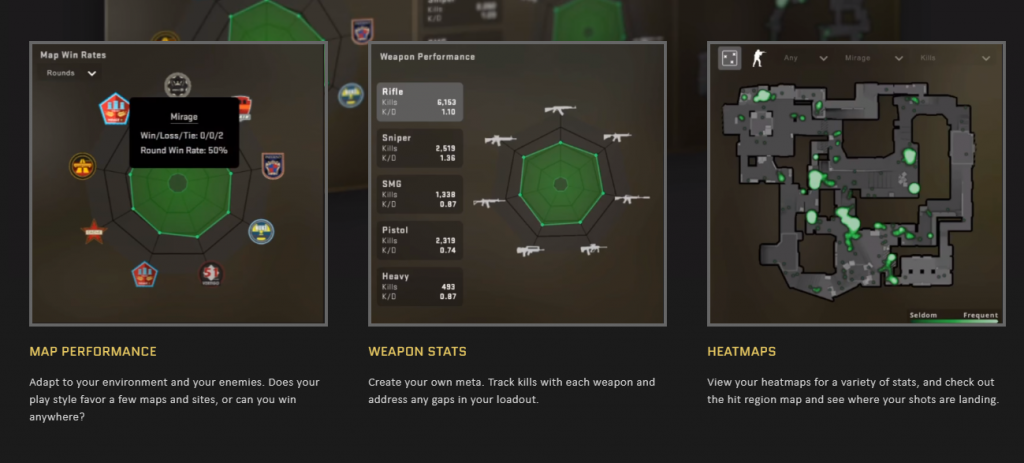

- CSGO STATS CODE
- CSGO STATS DOWNLOAD
NOTE: Remove this cell containing the instructions before making your submission.
Your work must not be plagiarized i.e. Your submission must include explanations using markdown cells, apart from the code. Your submission must include at least 5 visualizations (graphs). You must ask and answer at least 5 questions about the dataset. Dataset must contain at least 3 columns and 150 rows of data. 
Your submission will be evaluated using the following criteria: Understanding the Gender Divide in Data Science Roles by Aakanksha N SĢ020 Stack Overflow Developer Survey Results WhatsApp Chat Data Analysis by Prajwal Prashanth Your personal data from online servicesĪnalyzing your browser history using Pandas & Seaborn by Kartik Godawat.Recommended datasets for the course project.Use the following resources for finding interesting datasets: Know your enemies better Join a CS:GO game (works on any game mode) Wait until all players have connected Open your CS:GO console and write status, then. Check out the Jovian.ml Medium publication for inspiration:.
CSGO STATS CODE
Copy over the explanations from your Jupyter notebook into your blog post, and embed code cells & outputs. Sign up on to write a blog post for your project. A blog post is a great way to present and showcase your work. Upload your notebook to your Jovian.ml profile using mit.īrowse through projects shared by other participants and give feedback Step 6: Make a submission & share your work Share links to resources you found useful during your analysis. Share ideas for future work on the same topic using other relevant datasets. Include interesting insights and graphs from previous sections. Write a summary of what you've learned from the analysis. Step 5: Summarize your inferences & write a conclusion Wherever you're using a library function from Pandas/Numpy/Matplotlib etc. Create new columns, merge multiple dataset and perform grouping/aggregation wherever necessary. Answer the questions either by computing the results using Numpy/Pandas or by plotting graphs using Matplotlib/Seaborn. Ask at least 5 interesting questions about your dataset. Step 4: Ask & answer questions about the data Make a note of interesting insights from the exploratory analysis. Explore relationship between columns using scatter plots, bar charts etc. Explore distributions of numeric columns using histograms etc. Compute the mean, sum, range and other interesting statistics for numeric columns. Step 3: Perform exploratory Analysis & Visualization Perform any additional steps (parsing dates, creating additional columns, merging multiple dataset etc.). Handle missing, incorrect and invalid data. Explore the number of rows & columns, ranges of values etc. Load the dataset into a data frame using Pandas. Step 2: Perform data preparation & cleaning You can also combine data from multiple sources to create a large enough dataset. The dataset should contain at least 3 columns and 150 rows of data. If it's not in a compatible format, you may have to write some code to convert it to a desired format. The dataset should contain tabular data (rowsn & columns), preferably in CSV/JSON/XLS or other formats that can be read using Pandas. Look up raid clears and speedruns for all four Destiny 1 raids CSGO-STATS. CSGO STATS DOWNLOAD
Step 1: Select a real-world datasetįind and download an interesting real-world dataset (see the Recommended Datasets section below for ideas). CSGO Report Bot 20 Reports in 1 click to put suspect player to overwatch. Focus on documentation and presentation - this Jupyter notebook will also serve as a project report, so make sure to include detailed explanations whererver possible using Markdown cells. Use this starter notebook as an outline for your project (you can also start with an empty new notebook). For the course project, you will pick a real-world dataset of your choice and apply the concepts learned in this course to perform exploratory data analysis. This is the starter notebook for the course project for Data Analysis with Python: Zero to Pandas. This value is the same one passed to you when you sign in via Valve's OpenID.Data Analysis with Python: Zero to Pandas - Course Project Guidelines (remove this cell before submission) You'll replace > with your API key and > with the profile ID (not SteamID) of the user you are interested in. Your call will look like this: >&steamid=> Utilize the GetUserStatsForGame end point instead. I believe you are using the wrong API end point for this.






 0 kommentar(er)
0 kommentar(er)
